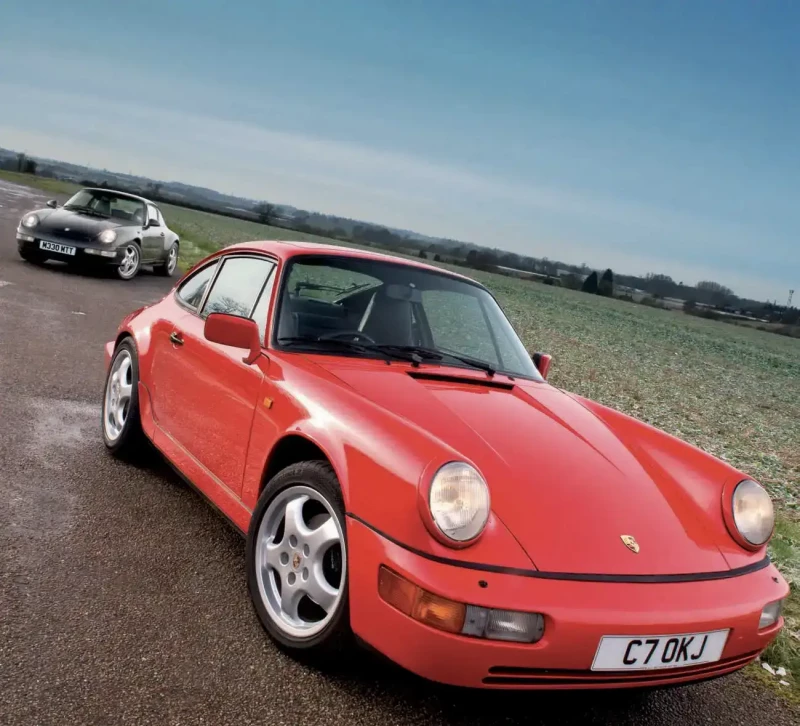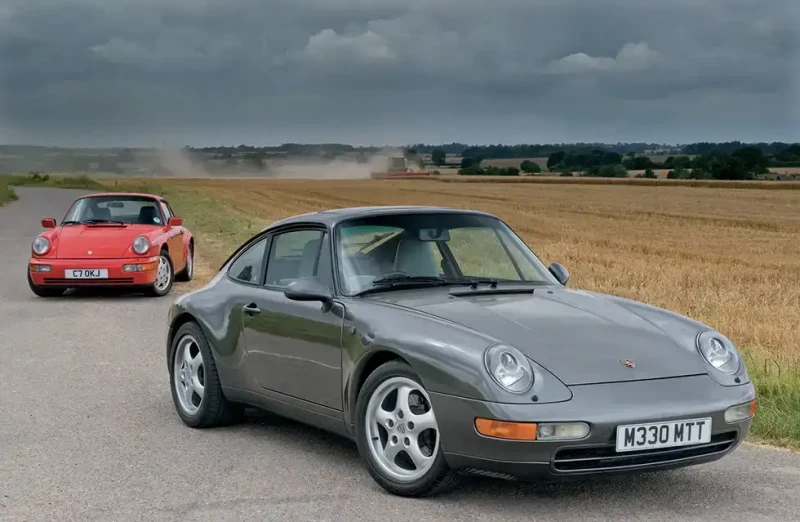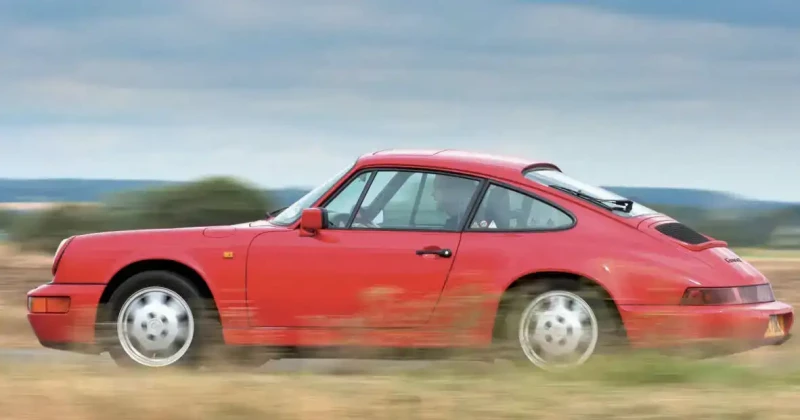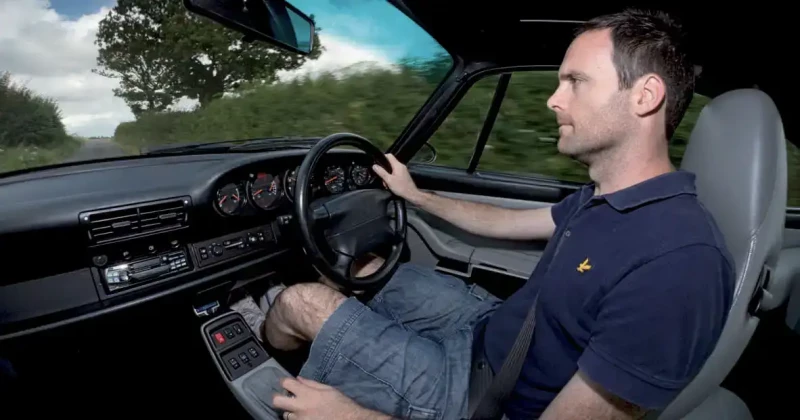1990 Porsche 911 Carrera 2 964 vs. 1994 Porsche 911 Carrera 2 993
The air-cooled 911 market is constantly evolving and no model is immune from the gravitational pull of ever increasing values witnessed by the ever decreasing gap between the 964 and the 993.
MARKET VALUES: 964 V 993
The 964’s time has come and good ones are pushing into 993 territory. We drive both.
964 V 993: THE RISE AND THE FALL
Words: Adam Towler
Photography: Antony Fraser
THE LAST OF THE AIR-COOLED 911S AND NOT THE CLEAR CUT CHOICE OF THE PAST
“From a purely personal perspective my natural response is to gravitate towards the 964”

If you’re forever keeping one eye on the Porsche market you’ll probably have noticed a particular pricing phenomenon in recent months. After years of being the poor relation in the modern-classic 911 arena, the 964 has suddenly built a passionate following. Prices have risen rapidly as a result. In doing so, it has begun to put pressure on the succeeding 993 variant – for so long the halo model in more recent 911 history. So we thought we’d get together an example of each – of the type most seem to want: a Carrera 2 coupe with a manual gearbox – and compare what your money is buying, and why the pricing structures have been on the move.
With an endless ream of magazine plaudits, and a dedicated following, the 993’s place as the pinnacle of the 911 world has looked assured for a long time. And by and large that still holds true, particularly for fine examples of the wide-body cars – the 2S and 4S – even though in period these were some of the very few 993s to receive mixed reviews from the motoring press. The blistering Turbo has its devotees, naturally, and as for the 993 RS, that particular bird has long since flown with values already heading north of £100,000 for the best examples.

But as the collective fleet of 993s gets older, so more and more cars fall into a general state of disrepair, either through excessive mileage, abuse, neglected maintenance – or a mixture of all three. So these days it’s easy to find a selection of 993s for well under £20,000, and even for clean, well-maintained Carrera 2 Coupes, the pricing has remained static.
Perhaps there are currently too many nice examples around for the prices to rise at present? Whatever, the model has slightly lost that air of residual value superiority it so long enjoyed.
But what of the 964? For so many years this was the 911 that by and large remained unloved, fed by mixed reviews at launch, horror stories of engines leaking oil like sieves and various other maladies. At the eye of the storm was the now fabled 964 RS, a car that had received a pasting from the majority of the motoring press for simply being too firm in the suspension dept to work on the public road. As such, RSs lived a life of being thrashed around the track days of Britain, with prices even dropping below £20,000 for well-used examples. And then something strange happened. The RS was recast as the last true road-racer, a brilliant drivers’ car, a highly collectible, blue chip Porsche. Ever since, people have been re-evaluating the 964, whether you agree with the clamour for the RS model or not.

Holding the keys to both types today (provided by specialist Paul Stephens), my natural response is to gravitate towards the 964. I know that’s from a purely personal perspective, but I think it might just demonstrate part of what has been going on. My brain says the 993 is the better car, a more sophisticated drive, but somehow the pugnacious, Guards Red 964, with its upright front wings and clean but chunky shape, just sucks me in. There’s something so utterly compelling about it, a feeling that it’s a ‘real’ 911, that has a magnetic attraction just as the 911 has done so for decades. I am fascinated by this subconscious battle, the contest between the head and the heart, but that doesn’t mean I’m anywhere nearer being able to explain it. Nevertheless, it would be wrong to portray the 964 as a primitive, firebrand of a 911 ready to hang you out to dry should you slip up as a driver. It was the 964 that brought the 911 kicking and screaming into the 20th century, with the modern integration of bumpers, up-to-date aerodynamic thinking, power steering, ABS, a decent heating system, and so on. That means you can just jump in one and drive away without thinking too hard about what you’re doing, if you should so wish to do so: that was Porsche’s key objective with the car, given that they had spent the best part of the decade up to that point selling 3.2 Carreras to by and large people who just wanted a Porsche key ring to display at the wine bar.

In creating such a machine, they angered the ‘purists’ who thought the soul had gone. Whatever the reality, the soul had certainly put on the pounds, and coupled with the far easier controls, made the 964 a more measured, but less thrilling car to drive than some of its forebears. Looked at another way though, today it’s a classic 911 that seems at ease in modern traffic, and can be driven hard without too much fear of anything untoward happening (granted, only up to a point). Despite its high miles, this red 964 is just such a case in point – and I love it partly for that very reason. It’s an easy car to drive, yet a rewarding one. The standard engine would benefit from a bit more of a ‘voice’ in the cabin (just my opinion, and easily achieved) but with a relatively under-stressed 250bhp, it feels more than quick enough for most tastes. The ride is firm, and you certainly feel every blemish in the road, but it’s not an uncomfortable car, just one that relays exactly what’s going on at the road surface in no uncertain terms. And then there’s that evocative view down the bonnet...

Jumping straight into the 993 (now sold as I write this, though Paul Stephens has a similar car for sale) is a strong contrast. The view out is different (without those wings to act as a gun sight) and the revised engine feels a good deal punchier, aided by the six-speed gearbox. It may well have helped that this 993 is a fine, low mileage example, but it feels appreciably faster – a modern sort of performance with which you’d feel confident in trading blows with cars more than one generation further down the line.
Even so, by far the biggest difference is the effect wrought by the 993’s multi-link rear axle. The 993 oozes down the road like melted chocolate compared with the bump and bang of the 964. It has a stunning sense of poise to it, unshaken by awkward jolts or camber changes from the road surface, and yet never feels loose or sloppy. It’s a comfortable car, easily able to provide long distance cruising comfort, but you wonder if there are those who mistake that sophistication for a lack of sporting intent. That couldn’t be further from the case – it’s just that the 993 makes everything seem so easy. When you combine that with the fabulously clear (ideal weighting and so talkative) power steering and a wonderful six-speed gearbox, you have a car that makes most modern sports cars look ludicrously ham fisted. We can only hope that Porsche makes its engineering apprentices drive a 993 before they get down to any serious work because there’s so much to appreciate in this car – and much you can’t help feeling that could do with being reintroduced in spirit to the new generation. And yet I still quite fancy the 964! And therein lies the difficulty of explaining away a love of cars, and of making sense of the market.
Charlie at Paul Stephens has some theories on the matter. As he says, “964s are on the up, and 993s are holding firm. The 964 is the last of the classic style Porsches, a car that allows you to relive the earlier cars in a more modern package, and where once everyone was chasing the latest technology by going for a 993, now they’re all out of date so it doesn’t really matter”. It seems that 964 and 993 buyers have quite different approaches too, in Charlie’s experience the former willing to consider a car with well over 100,000 miles on the clock – “they battle on to 200,000 miles if they’re well maintained and looked after” – and one that might need work, whereas 993 buyers tend to be looking for that perfect, low miles car and obsess about history and originality. In his experience, “993s tend to be either very good cars, or very average ones”.
The bottom line, however, is that there’s no escaping the fact that decent examples of either are becoming harder to find, and that can only lead to price rises as supply wilts under the pressure of demand. “You need to be lucky”, quips Charlie when pondering the buyers’ prospects in the current market. It’s also true that the UK market is currently losing a lot of nice cars to overseas markets, particularly the Far East.
What these steady price increases for the 964 have meant, is that those that buy wisely, and who then aren’t unlucky with running costs, can probably afford to run one and then sell on after a couple of years having enjoyed effectively free motoring. It’s a market theory that Darren Anderson at RPM Porsche agrees with: “The last couple of years has seen a levelling of pricing between the 964 and 993 which in our opinion was well overdue. As a result the difference between good 964s and good 993s has narrowed to the point that they now overlap” (something illustrated by Paul Stephens recently selling low mileage 964s in the £30,000-£40,000 bracket). Prices for both models tend to start in the mid teens, with excellent examples now stretching beyond £20,000, including well-sorted replicas of the 964 RS. And as Darren goes on to point out, “The valuation process on any air cooled 911 is not as straightforward as model year, mileage, condition and service history. Other factors that have a huge influence on valuation are whether it has had an engine build (and by whom), what level of corrosion is present and what major work has been completed in the recent history”. When it comes to modified cars, the 964 has always attracted those looking to make a replica of an RS. In fact, so popular has the car been for aftermarket embellishment (or otherwise as the case may be) that it’s almost harder to find a standard car than a modified one – particularly if you’re looking for a C2 manual (the obvious starting point for an ‘RS’).
Anderson agrees: “The 964 has been the air-cooled car of choice for modification and cars that have been sympathetically modified are fetching strong money. The 993 to date hasn’t often been modified as the values were high in the first place and most buyers wanted 100% original and unmolested examples. I suspect this will change as the 993 is now more affordable and the 964 has demonstrated that modified examples fetch strong money. Porsche never sold that many 964s – the model arrived at the onset of a particularly dark period in the history of the company, whereas the 993 will forever be associated with the rebirth of Porsche into the hugely successful concern it is today. Ask me which of these two cars I’d rather drive and it almost comes down to which day of the week it is and what mood I’m in. There’s no doubt one is the better car, but there would also be plenty of occasions where the older car holds the greater appeal for reasons that are harder to put into words. It’s a similar sort of argument that rages over the new 991: technical progress makes it easier to drive and yet faster around the Nürburgring than ever before, and yet… and yet there are many of us that wish it conjured up the same sort of emotions concocted when driving a 993, or a 964 – faults and all. Or is that because of the faults? Either way, while your money looks set to be safe in a 993, it’s the 964 that’s gaining the ground at the moment, and the years of bargain basement prices look set to be a thing of the past.
TECHNICAL SPECIFICATIONS 1994 Porsche 911 Carrera 2 993
- YEAR: 1994
- ENGINE: 3600cc
- MAX POWER: 272bhp at 6100rpm
- MAX TORQUE: 243lb ft at 5000rpm
- TRANSMISSION: Six-speed, G50 manual
- TOP SPEED: 167mph
- ACCELERATION 0-60MPH: 5.6 secs
- SUSPENSION: MacPherson strut front, multi-link rear
- TYRES: 205/55 ZR16 front, 245/45 ZR16 rear
Above: Capacity remained at 3.6-litres for the 993, but power was increased to 272bhp. Later Varioram versions would have 285bhp. Below: We’re really very sorry about Adam’s legs!
Above: The interior took another step forward with the arrival of the 993 model 911, although dimensionally it was still as snug as ever. Below: Dark metallic grey suits the 993 and marks the start of a period that saw colour tastes in the UK change. The market still favours the more subtle colours
CONTACT: Paul Stephens Ltd, Sudbury Road, Little Maplestead, Halstead, Essex Web: www.paul-stephens.com Tel: +44 (0)1440 714884 RPM Technik Old Airfield Industrial Estate, Cheddington Lane, Long Marston, Hertfordshire HP23 4QR Web: www.rpmtechnik.co.uk Tel: +44(0)1269 663824
Above: The D90 wheel is clean and simple, but no replacement for the classic Fuchs. Centre console topped the transmission tunnel and was required to house the four-wheel drive system.
Below: The 964 C2 is snake-hipped, while the 993 has the rounder rear
TECHNICAL SPECIFICATION 1990 Porsche 911 Carrera 2 964
- YEAR: 1990
- ENGINE: 3600cc
- MAX POWER: 250bhp at 6100rpm
- MAX TORQUE: 229lb ft at 4800rpm
- TRANSMISSION: Five-speed, G50 manual
- TOP SPEED: 161mph
- ACCELERATION 0-60MPH: 5.7 secs
- SUSPENSION: MacPherson strut front and rear
- TYRES: 205/55 ZR16 front, 225/50 ZR16 rear
Above: The 964 heralded the first major makeover for the 911 since its conception in 1963. Big bumpers front and rear, plus side skirts were the visual clues, plus the D90 wheels.
Underneath MacPherson struts replaced torsion bars and the engine grew to 3.6-litres. The interior was modernised too


